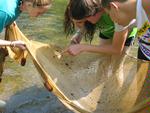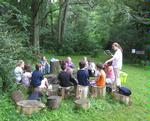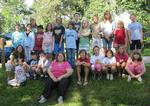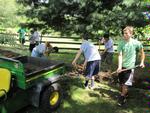News & Events
Notes from the Field Station: Campers and Kids at the Field Station
Posted on Monday, August 2, 2010
The summer's activities at the Field Station involved children and adults of the College and the community getting to know interesting and useful facts of nature and applying those facts. That is how science operates.
Not all of these structured activities might be called camps but they surely were adventures, ranging from an all-day workshop on solar energy for adults to a weeklong day camping program for elementary school children. Physical labor of various sorts accompanied some of the "campers."
The Neshannock High School Advanced Biology class, taught by Mrs. Nancy Blank, a Westminster alumna, and Dr. Stephanie Corrette-Bennett, from Westminster's Science in Motion Program, came out on May 27 to study the macroinvertebrates of the Little Neshannock Creek. The question posed was, is this a healthy stream? Based on the specific invertebrates of the bottom sediments, the stream is marginal in quality. It could be better-or worse-from the quality viewpoint.
A workshop on June 6 was a theory and application project on alternative energy. Dr. Helen Boylan, associate professor of chemistry, and Dr. Douglas Armstead, assistant professor of physics, explained how solar energy can be transformed into electrical energy. Then the work began: placing solar panels on the roof of the shed. Dr. Armstead and John Edmiston, a certified electrician and Westminster alumnus, supervised the placement of 11 panels.
Bear Tree Connections, an environmental club of Wilmington Area with its home base at the Field Station, had an evening of creek stompin' June 16 as they, too, looked for the critters that signify the quality of freshwater streams. These kids have done this before and will most likely do it again. An old adage is that you cannot step into the same river twice. This means that a continual monitoring of the Little Neshannock Creek is needed because its quality may vary from year to year, month to month.
The children's day camp this year operated June 28-July 1. Elementary school children in grades one-six who used the Field Station, grappled with amphibians and other critters. They developed skills of nature art. Their teachers were Miss Emily Stock, Mrs. Connie White and Mrs. Laraine Stock (a Westminster alumna) from the Wilmington Area Schools. What better place to study science than the outdoors! Enthusiasm was high and the weather was good, a proper combination.
The last groups to make appearances at the Field Station July 26-29 were high school students attending the New Wilmington Mission Conference at Westminster. Four different batches of young folk who came from far-flung places were service teams. Their service amounted to physical labor, digging a trough for laying down a trail through a section of the yard of the Field Station that will be part of a Garden Spot, a memorial to Dr. Edward Gese, former member of the Department of Biology.
After all of this, we might say that summer without campers at the Field Station would be ________ (you fill in the blank). "Empty" comes to my mind!
Clarence Harms, Director
Field Station
harmsc@westminster.edu




More Stories



